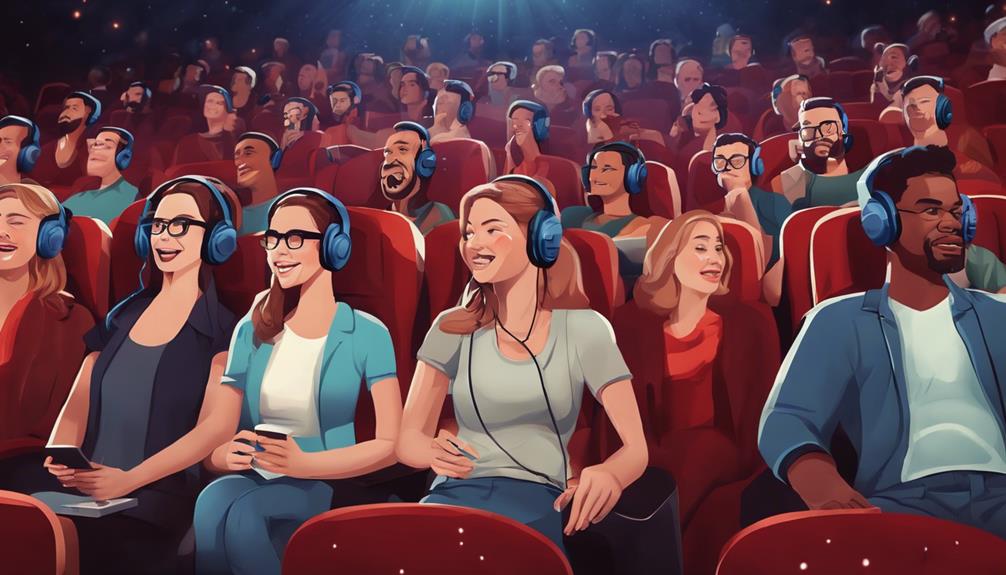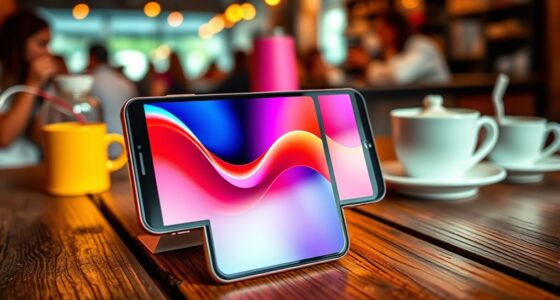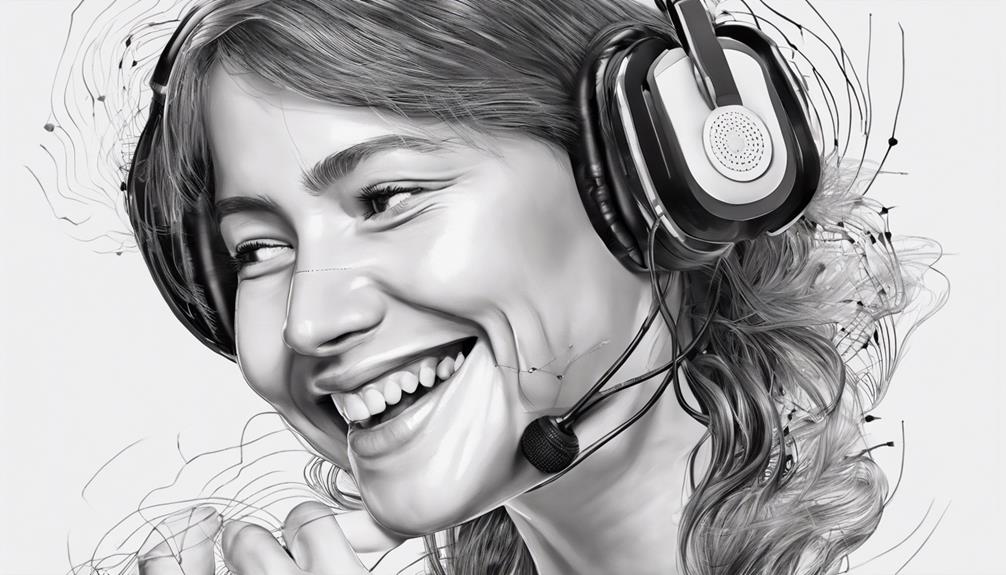Picture this scene: immersing yourself in a cinematic journey where every whispered dialogue, every explosion of sound, and every musical score comes through with exceptional clarity. The use of assistive listening devices in cinemas enhances this immersive experience, adding a new level of engagement that goes beyond just watching.
But what if these devices could do more than just enhance sound quality? How about delving into the realm of personalized audio experiences tailored to individual preferences, transforming the way we perceive movies on the big screen?
Key Takeaways
- Assistive listening devices enhance movie experiences for individuals with hearing loss.
- Open and closed captions ensure full engagement and understanding for all viewers.
- Improved dialogue comprehension fosters inclusivity and enriches the movie-watching experience.
- Induction loop systems offer enhanced sound clarity and cost-effective accessibility benefits.
Advantages of Assistive Listening Devices
Assistive listening devices significantly enhance the movie-watching experience for individuals with hearing loss by providing clear and customizable audio, meeting legal accessibility requirements, and improving satisfaction levels among patrons.
These devices play a crucial role in increasing accessibility in movie theaters, ensuring that all individuals, regardless of their hearing abilities, can enjoy films with improved sound quality. By reducing background noise and offering customizable volume levels, assistive listening devices cater to the specific needs of each user, creating a more immersive and enjoyable viewing experience.
Moreover, these devices support multiple users simultaneously, making it possible for individuals with varying degrees of hearing loss to benefit from enhanced dialogue comprehension.
The implementation of assistive listening devices not only benefits individuals with hearing impairments but also contributes to creating a more inclusive and diverse movie-watching environment. Overall, these devices play a vital role in enhancing the overall movie experience for all patrons.
Types of Listening Devices Available
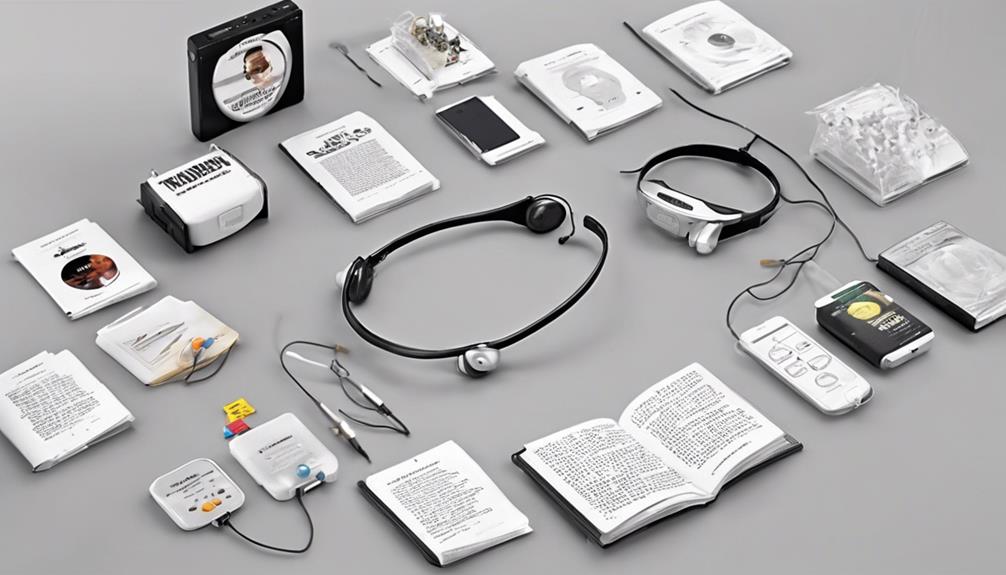
To explore the diverse range of listening devices available in theaters, we'll delve into the specifics of FM systems, infrared systems, Bluetooth-enabled devices, personal amplification systems, and induction loop systems.
FM systems utilize frequency modulation to reduce background noise and enhance clarity, making them ideal for individuals with hearing impairments seeking improved sound quality. Infrared systems transmit audio signals via infrared light, providing secure and reliable sound transmission within designated areas.
Bluetooth-enabled devices offer wireless connectivity, enabling seamless integration with personal devices like smartphones or tablets, enhancing convenience and accessibility. Personal amplification systems allow users to customize volume levels according to their specific hearing preferences, providing tailored auditory support.
Induction loop systems transmit sound directly to compatible hearing aids through electromagnetic fields, optimizing the audio experience for individuals with hearing devices. The array of assistive listening devices available in theaters caters to diverse needs, ensuring an inclusive and enhanced movie-watching experience for all patrons.
Benefits of Open Captions
Open captions offer increased accessibility for all viewers, ensuring that individuals with hearing loss can fully engage with the dialogue and sounds of a movie. They provide an improved understanding of the storyline by displaying text on the screen, making it easier for diverse audiences to follow along seamlessly.
Open captions eliminate the need for additional equipment, creating a convenient and inclusive movie-watching experience for all patrons.
Increased Accessibility for All
Implementing open captions in theaters revolutionizes the movie-watching experience by providing universal accessibility for individuals with hearing impairments. Open captions are a permanent part of the movie, eliminating the need for separate devices or setups. They help deaf and hard of hearing individuals follow the dialogue and enjoy the movie experience. Movie theaters can schedule specific showings with open captions to cater to diverse audience needs. Open captions enhance inclusivity and ensure that everyone can fully engage with the film regardless of their hearing abilities.
| Benefit of Open Captions | Details |
|---|---|
| Universal Accessibility | Provides access to individuals with hearing impairments |
| Permanent Inclusion | Eliminates the need for external captioning devices |
| Inclusive Movie Experience | Allows everyone to follow the dialogue and enjoy the film without barriers |
Improved Understanding of Dialogue
Enhancing dialogue comprehension through the utilization of open captions in theaters significantly improves the movie-watching experience for individuals with hearing impairments. Open captions, displaying text on the screen, serve as a vital visual aid for understanding dialogue, particularly benefiting those with hearing loss.
For individuals with severe hearing impairments or who are Deaf, open captions are instrumental in ensuring a clear grasp of spoken words throughout the film. The presence of open captions not only enhances accessibility but also fosters inclusivity for diverse audiences.
Understanding Sound Systems

We'll explore the fundamentals of sound systems in theaters, including the various types of audio systems commonly employed.
Understanding the basics of sound systems is crucial for grasping how theaters deliver high-quality audio experiences.
Sound System Basics
Understanding sound systems in theaters is essential for creating a captivating auditory experience for moviegoers. The sound systems in movie theaters are meticulously calibrated to deliver a wide range of amplified sound, typically ranging from 74 to 104 decibels, ensuring an immersive audio experience.
These systems are engineered to enhance dialogue clarity and provide dynamic sound effects, enriching the overall movie-watching experience. Utilizing surround sound configurations, theaters craft a spatial audio environment that draws audiences into the on-screen action.
Incorporating subwoofers, tweeters, and multiple speakers, modern sound systems in theaters deliver detailed and rich sound throughout the auditorium. By meeting industry standards and maintaining consistent audio quality across various genres, these sound systems play a crucial role in elevating the cinematic experience.
Types of Audio Systems
Movie theaters implement various types of audio systems to enhance the auditory experience for viewers, each tailored to meet diverse hearing needs and preferences. These systems include Closed Captions and Open Captions, essential for ensuring accessibility to all moviegoers.
Additionally, theaters may utilize Induction Loops, which transmit sound directly to hearing aids equipped with telecoils. FM Systems are also common, broadcasting audio through radio frequencies to compatible devices.
Furthermore, some theaters offer MobileConnect Apps, enabling patrons to connect their smartphones to headphones for personalized listening experiences. By incorporating these technologies, theaters can cater to a wide range of audience requirements, providing an inclusive and immersive cinematic experience for all.
Importance of Closed Captions

Closed captions play a crucial role in ensuring equal access to movies for individuals with hearing impairments by providing text on the screen to aid in dialogue comprehension and storyline understanding. These captions are not just a convenience but a necessity for those who rely on visual cues to follow the plot amidst noisy theater environments. Mandated by law, closed captions in theaters ensure accessibility for all patrons, including those with hearing impairments, significantly enhancing the movie-watching experience for individuals with varying degrees of hearing loss. By utilizing closed captions, individuals can fully immerse themselves in the film, capturing crucial dialogue and plot intricacies that would otherwise be missed. Here is a table highlighting the importance of closed captions:
| Key Points | |
|---|---|
| Provide text for dialogue comprehension | Essential for individuals with hearing loss |
| Aid in understanding the storyline | Mandated by law in theaters for accessibility |
| Enhance movie-watching experience | Ensure equal access for all patrons, improving engagement |
Exploring FM Systems

FM systems are sophisticated technology that utilizes frequency modulation to wirelessly transmit audio signals in theaters. These systems excel at reducing background noise interference, ensuring optimal sound clarity for individuals with hearing impairments.
In theaters, FM systems offer compatibility with hearing aids, customizable volume settings, and the ability to support multiple users simultaneously, making them ideal for group settings.
FM System Overview
Utilizing radio signals, FM systems transmit sound directly to personal devices like headphones or hearing aids, effectively minimizing background noise to enhance audio clarity for individuals with hearing impairments.
In theaters, these systems play a crucial role in improving dialogue comprehension by ensuring that users can adjust the volume levels to suit their specific hearing needs. By utilizing FM technology, multiple users can simultaneously benefit from enhanced sound quality in a movie theater setting.
The ability to reduce background noise and customize volume levels makes FM systems a valuable tool for individuals with hearing impairments seeking an optimal movie experience. These systems are designed to provide a tailored audio solution that prioritizes clarity and comfort for users in diverse theater environments.
Benefits of FM
How can FM systems revolutionize the auditory experience for individuals with hearing impairments in theaters? FM systems are a game-changer due to their unique benefits:
- Enhanced Clarity: By reducing background noise, FM systems significantly improve the clarity of sound for those with hearing loss.
- Portable: These systems are portable, allowing users to move freely within the theater while still receiving clear audio.
- Customized Listening: FM systems can be used with headphones or personal hearing devices, offering a tailored listening experience.
- Consistent Quality: With advanced technology, FM systems ensure consistent audio quality and volume levels for users in any seating area.
The versatility and effectiveness of FM systems make them an excellent choice for providing assistive listening solutions in theaters and other public venues.
Usage in Theaters
Exploring the practical application of FM systems in theaters reveals a transformative solution for enhancing the auditory experience of individuals with hearing impairments. These devices utilize frequency modulation to transmit audio signals directly to personal receivers, effectively reducing background noise and improving sound clarity for those with hearing loss.
Utilizing Induction Loops
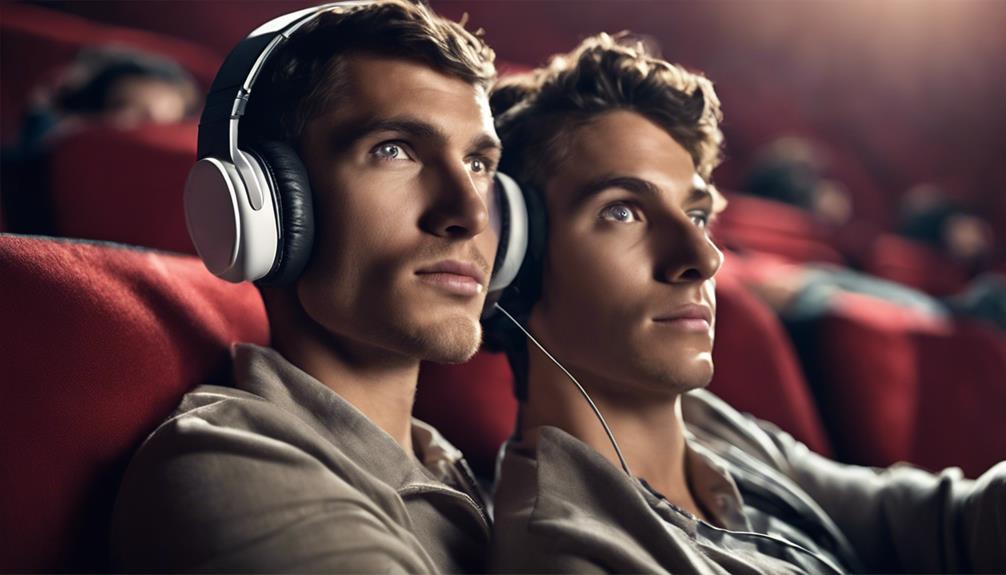
Induction loops, utilizing electromagnetic fields, wirelessly transmit sound directly to compatible hearing aids for enhanced auditory experiences in theaters, concert halls, and various public venues. When utilizing induction loops, individuals with T-coil equipped hearing aids benefit from seamless connectivity and improved sound quality.
Here are key points to consider:
- Enhanced Sound Clarity: Induction loops provide clearer sound by reducing background noise, making dialogue easier to understand.
- Improved Accessibility: Installed in public venues, these systems enhance inclusivity for individuals with hearing loss, ensuring everyone can enjoy performances and events.
- Cost-Effective Solution: Induction loops offer an efficient and affordable way to boost accessibility in various settings without the need for individual receivers.
- User-Friendly Connectivity: Users with T-coil equipped hearing aids can effortlessly connect to induction loop systems, enhancing their overall listening experience.
Enhancing With Hearing Aids

Hearing aids present a valuable tool for enhancing auditory experiences for individuals with mild-to-moderate hearing loss in theaters, especially when adjusting the volume to optimize movie-watching enjoyment. By fine-tuning the volume settings on their hearing aids, individuals with mild hearing loss can immerse themselves in the movie experience without missing crucial dialogue or sound effects. Movie theaters often cater to those using hearing aids by providing a listening environment that complements these devices. Here is a table highlighting the benefits of enhancing movie experiences with hearing aids:
| Benefits of Using Hearing Aids in Movie Theaters |
|---|
| 1. Improved dialogue clarity |
| 2. Enhanced sound effects immersion |
| 3. Customizable volume settings |
| 4. Better overall movie-watching experience |
| 5. Accommodation for mild hearing loss |
Utilizing hearing aids can significantly improve the quality of the movie-watching experience for individuals with mild hearing impairments, ensuring they can enjoy movies to the fullest.
MobileConnect App Insights
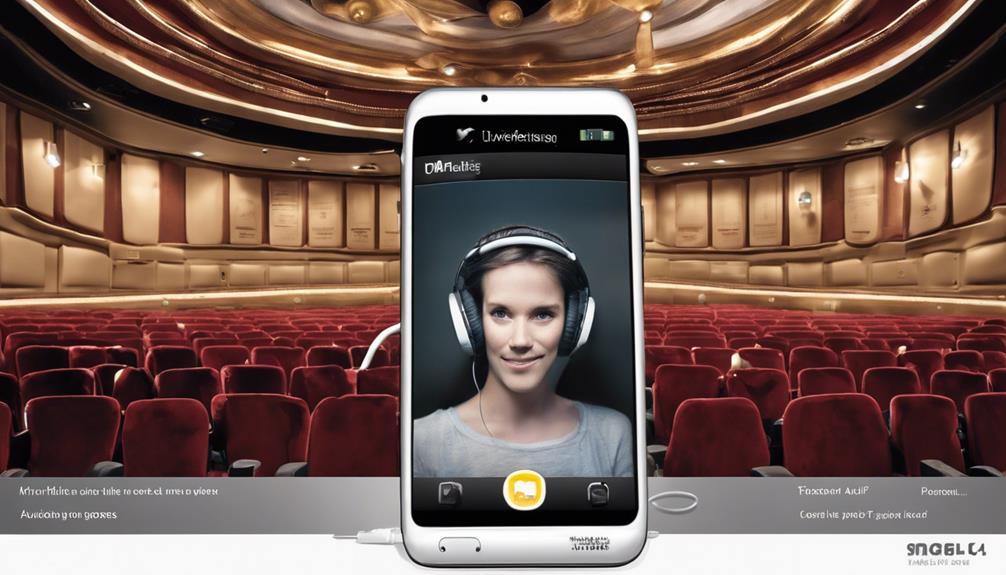
Utilizing the MobileConnect App enhances the movie-watching experience by connecting headphones wirelessly to smartphones, providing users with personalized audio and improved dialogue comprehension.
The following insights shed light on the capabilities of the MobileConnect App:
- Improved Audio Quality: The MobileConnect App enables users to experience enhanced audio quality, making dialogue and sound effects clearer and more immersive.
- Customizable Listening Experience: Users have the flexibility to adjust volume levels and customize audio settings according to their preferences, ensuring a tailored movie-watching experience.
- Support for Multiple Users: This app allows multiple users to connect simultaneously, making it ideal for group outings where friends and family can enjoy movies together with personalized audio streams.
- Enhanced Accessibility for Hearing Loss: The MobileConnect App caters to individuals with varying degrees of hearing loss, providing them with a convenient and modern solution to enhance their movie experience using assistive listening devices.
Advancements in Infrared Technology
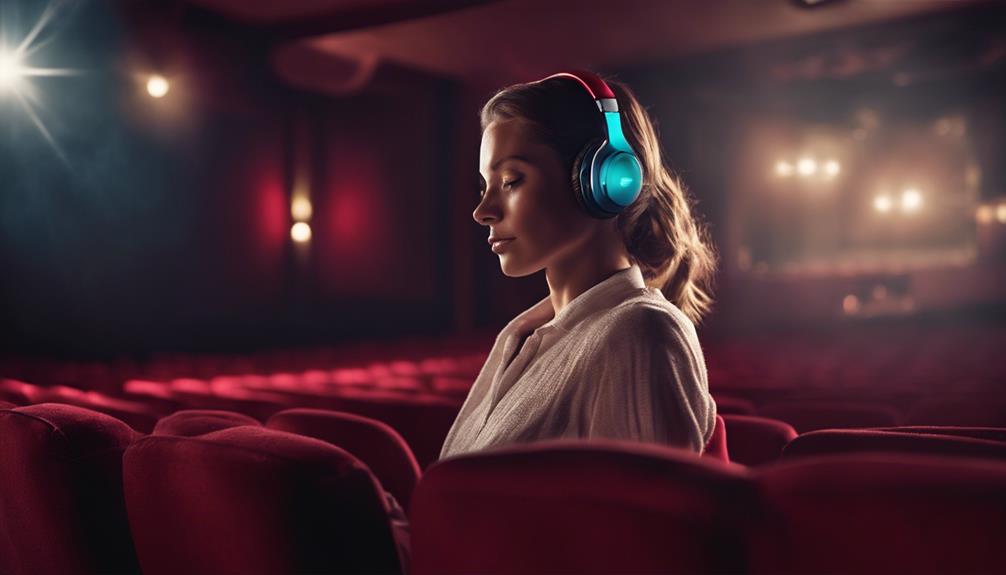
Exploring the latest advancements in Infrared Technology reveals how theaters are revolutionizing audio transmission for a more immersive and personalized movie-watching experience. Infrared technology in theaters transmits audio signals wirelessly using infrared light, ensuring secure and interference-free sound delivery to users' headphones or hearing aids. This technology provides a more private listening experience compared to other assistive devices, allowing users to enjoy clear and synchronized audio without external disturbances. The line-of-sight nature of Infrared technology enables precise and targeted audio delivery to individual users, enhancing the overall movie-watching experience. The table below highlights the key features of Infrared technology in theaters:
| Features | Description | Benefits |
|---|---|---|
| Secure and interference-free | Ensures reliable audio transmission without disruptions. | Enhanced audio quality and uninterrupted listening. |
| Private listening experience | Offers a more secluded and personalized audio experience. | Increased immersion and focus during movie screenings. |
| Precise and targeted delivery | Delivers sound directly to individual users within line-of-sight range. | Tailored audio experience for each viewer. |
Frequently Asked Questions
What Is Assistive Listening Devices in Movie Theaters?
Assistive listening devices in movie theaters encompass systems like FM, infrared, and induction loop technology. These devices are designed to aid individuals with hearing loss by enhancing sound quality and reducing background noise.
They're legally mandated in theaters to provide inclusivity for patrons with hearing impairments. Through the use of these devices, users can experience clearer dialogue and improved comprehension, catering to varying degrees of hearing loss for an enhanced movie-watching experience.
How Can I Improve My Movie Theater Experience?
To enhance our movie theater experience, we can explore various options like closed captioning for dialogue clarity, open caption screenings for inclusivity, and personal amplification systems for customizable volume levels.
Researching theaters offering these features and utilizing mobile apps for personalized audio can also improve our enjoyment.
Are Movie Theaters Required to Have Assistive Devices?
Yes, movie theaters with fixed seating for 50 or more patrons are mandated by the ADA to provide assistive listening devices. Title III of the ADA ensures effective communication for those with hearing impairments.
The law guarantees accessibility, minimizing exclusion and communication barriers for individuals with hearing loss. Compliance with legal requirements for assistive devices is nearly universal in US movie theaters, facilitating an inclusive movie-watching experience for all patrons.
How Can I Hear Better at a Movie Theater?
To hear better at a movie theater, we recommend utilizing assistive listening devices like FM systems, infrared technology, or induction loops. These devices can enhance sound clarity and improve your overall movie-watching experience.
Additionally, exploring theaters with closed captioning and open captioning options can also help individuals with varying degrees of hearing loss enjoy movies to the fullest.
Personalized assistive listening technology can be particularly beneficial for those with severe hearing impairments.
Conclusion
In conclusion, the use of assistive listening devices in theaters offers a transformative and immersive movie-watching experience for all patrons. By enhancing sound quality, reducing background noise, and increasing accessibility, these devices provide a more inclusive and enjoyable environment for individuals with hearing loss.
Embracing this technology not only improves the overall movie experience but also promotes a more inclusive and accommodating atmosphere for all moviegoers.

